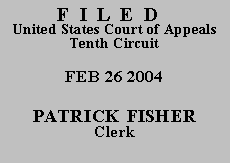

| UNITED STATES OF AMERICA, |
|
| v. | |
| MICHAEL WAYNE WRIGHT, |
Defendant-Appellant Michael Wayne Wright challenges application of the career offender provisions of U.S.S.G. § 4B1.1 to his case. Mr. Wright pleaded guilty to distribution of approximately 113.4 grams of a mixture containing methamphetamine. At sentencing, over Defendant's objection, the district court found that as a result of prior convictions for aggravated escape and aggravated assault, Defendant qualified for career offender status under the Sentencing Guidelines. The court sentenced Mr. Wright to 188 months imprisonment. Judgment was entered on June 23, 2003, and Defendant appeals.
To determine whether Defendant qualified as a "career offender," the district court properly considered the requirements of U.S.S.G. § 4B1.1. Under that section, Mr. Wright
is a career offender if (1) he was at least eighteen years old at the time he committed the instant offense of conviction; (2) the instant offense of conviction is a felony that is either a crime of violence or a controlled substance; and (3) the defendant has at least two prior felony convictions of either a crime of violence or a controlled substance.
U.S.S.G. § 4B1.1(a). At issue here is whether Mr. Wright's prior felony conviction for aggravated escape was a "crime of violence."
The term "crime of violence" is defined in U.S.S.G. § 4B1.2(a) as:
[A]ny offense under federal or state law, punishable by imprisonment for a term exceeding one year that --
Id. (emphasis added). U.S.S.G. § 4B1.2, comment. n.1, lists ten offenses which are each, by definition, a "crime of violence." "Escape" is not included in that listing. However, the guidelines provide that other non-listed offenses constitute crimes of violence where "the conduct set forth (i.e., expressly charged) in the count of which the defendant was convicted . . . by its nature, presented a serious potential risk of physical injury to another." U.S.S.G. § 4B1.2, comment. n.1.
This Court has repeatedly held that prison escape constitutes a "crime of violence" because it "involves conduct that presents a serious potential risk of physical injury to another." United States v. Gosling, 39 F.3d 1140, 1142-43 (10th Cir. 1994); accord United States v. Springfield, 196 F.3d 1180, 1185 (10th Cir. 1999); United States v. Moudy, 132 F.3d 618, 620 (10th Cir. 1998); United States v. Mitchell, 113 F.3d 1528, 1533 (10th Cir. 1997).
Defendant acknowledges the force of these precedents, but submits that "the rule of the cases is contrary to the wording and intent of the career offender guideline." Appellant's Br. 8. We are not persuaded, but even if we were, we would be bound by the earlier decisions of this Court. United States v. Ensminger, 174 F.3d 1143, 1146-47 (10th Cir. 1999). Defendant offers no basis for distinguishing these precedents, and we perceive none.
The judgment of the United States District Court for the District of Kansas, is therefore, AFFIRMED.
Entered for the Court,
Michael W. McConnell
Circuit Judge
*.This order and judgment is not binding precedent, except under the doctrines of law of the case, res judicata, and collateral estoppel. The court generally disfavors the citation of orders and judgments; nevertheless, an order and judgment may be cited under the terms and conditions of 10th Cir. R. 36.3.